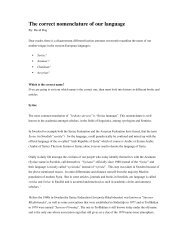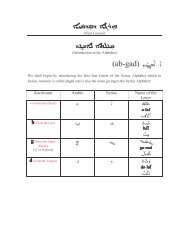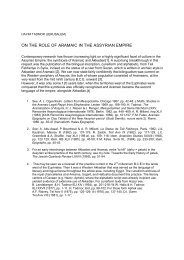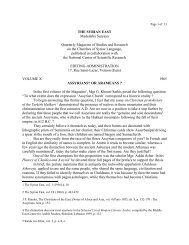The White Syrians Of Aramaean Cappadocia
The White Syrians Of Aramaean Cappadocia
The White Syrians Of Aramaean Cappadocia
You also want an ePaper? Increase the reach of your titles
YUMPU automatically turns print PDFs into web optimized ePapers that Google loves.
Such is a brief abstract of the account in Diodorus, the fabulous nature of which is<br />
still more apparent in the details of his narrative. We have already pointed out, in<br />
the article Sardanapalus, the mythical character of the whole of the Assyrian history<br />
of Ctesias, and it is therefore unnecessary to dwell further upon the subject in the<br />
present place. A recent writer has brought forward many reasons for believing that<br />
Semiramis was originally a Syrian goddess, probably the same who was<br />
worshipped at Ascalon under the name of Astarte, or the Heavenly Aphrodite, to<br />
whom the dove was sacred (Lucian, de Syria Dea. 14,33,39). Hence the stories of<br />
her voluptuousness (Diod. ii.13), which were current even in the time of Augustus<br />
(Ovid, Am. i.5.11). (Compare Movers, Die Phönizier, p.631.)<br />
[COMMENT: <strong>The</strong>se mythical references are quite intriguing, because at the time<br />
of Semiramis, <strong>The</strong> Cosmic Tree was still in place, tethered to our North Pole.<br />
Perhaps Semiramis was indeed a "demi-goddess" who was taken up to dwell in<br />
immortality with the "gods" of "Mount Olympus"! RS]<br />
*****<br />
A Dictionary of the Bible By Professor William Smith & Others (Boston, 1863),<br />
Volume I, Page 275.<br />
CAPPADOCIA. <strong>The</strong> eastern district of Asia Minor is interesting in reference to<br />
New Testament history only from the mention of its Jewish residents among the<br />
hearers of St Peter's first sermon (Acts ii.9), and its Christian residents among the<br />
readers of St. Peter's first Epistle (1 Pet. i.1). <strong>The</strong> Jewish community in this region,<br />
doubtless, formed the nucleus of the Christian; and the former may probably be<br />
traced to the first introduction of Jewish colonists into Asia Minor by Seleucus<br />
(Joseph. Ant. xii.3,§4). <strong>The</strong> Roman period, through the growth of large cities and<br />
the construction of roads, would afford increased facilities for the spread both of<br />
Judaism and Christianity. It should be observed that <strong>Cappadocia</strong> was easily<br />
approached from the direction of Palestine and Syria, by means of the pass called<br />
the Cilician Gates [modern Gulek Pass, RS], which led up through the Taurus<br />
[Mountains] from the low coast of Cilicia [modern Adana area, RS], and that it was<br />
connected, at least under the later Emperors, by good roads with the district beyond<br />
the Euphrates.<br />
<strong>The</strong> range of Mount Taurus and the upper course of the Euphrates may safely be<br />
mentioned, in general terms, as natural boundaries of <strong>Cappadocia</strong> on the south and<br />
east. Its geographical limits on the west and north were variable. In early times the<br />
name reached as far northwards as the Euxine [Black] Sea. <strong>The</strong> region of<br />
<strong>Cappadocia</strong>, viewed in this extent, constituted two satrapies under the Persians, and<br />
afterwards two independent monarchies. One was <strong>Cappadocia</strong> on the Pontus, the<br />
other <strong>Cappadocia</strong> near the Taurus. Here we have the germ of the two Roman<br />
provinces of Pontus and <strong>Cappadocia</strong>. Several of the monarchs who reigned in<br />
<strong>Cappadocia</strong> Proper bore the name Ariarathes. One of them is mentioned in 1 Macc.










